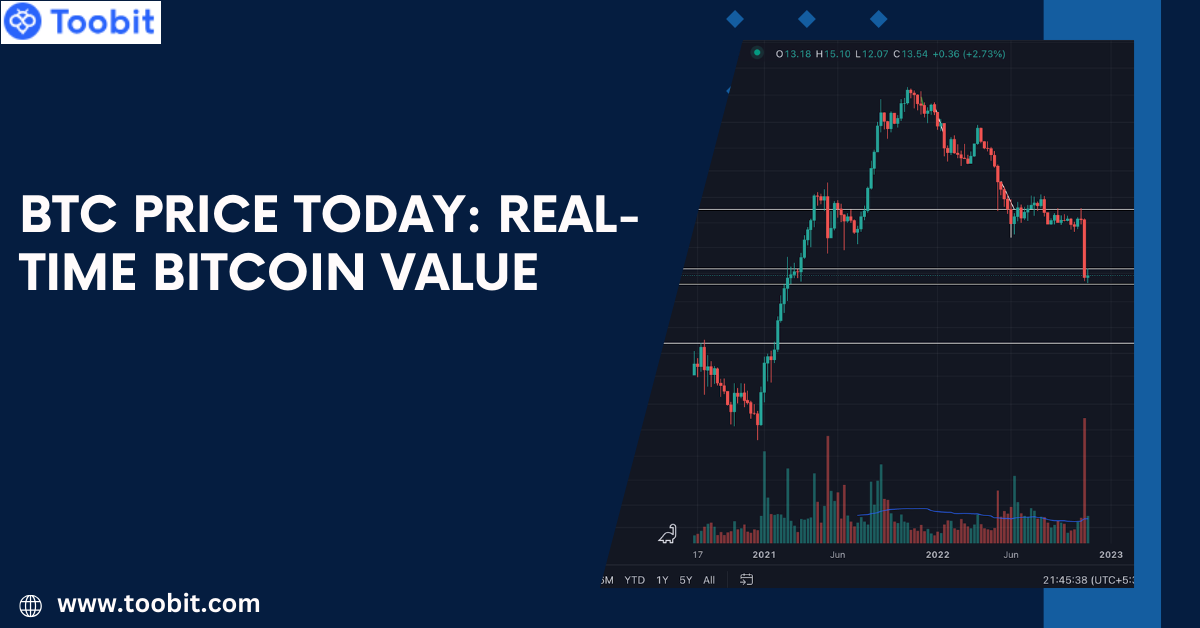Bitcoin (BTC), the world’s most well-known cryptocurrency, continues to dominate headlines and capture the attention of investors, traders, and financial analysts around the globe. Its value has fluctuated dramatically since its inception in 2009, and staying updated on the BTC price today is crucial for those involved in the cryptocurrency market. Understanding the factors influencing Bitcoin’s real-time value, its historical trends, and the tools available for tracking it can help you navigate this dynamic financial landscape.
The Journey of Bitcoin’s Price
Bitcoin’s price journey is a story of extreme volatility, driven by a combination of technological innovation, market speculation, and evolving regulatory environments. When Bitcoin was first introduced, it was virtually worthless, with early transactions such as the famous “Bitcoin Pizza Day” in 2010—where 10,000 BTC were exchanged for two pizzas—illustrating its initial novelty.
Over the years, Bitcoin’s price has experienced several notable surges. In 2013, Bitcoin crossed the $1,000 mark for the first time, sparking widespread interest. However, it was in 2017 that Bitcoin captured global attention when its price skyrocketed to nearly $20,000 in December of that year. This dramatic rise was followed by a significant correction, with the price dropping to around $3,000 in 2018.
The next major rally occurred in late 2020, when Bitcoin surpassed its previous all-time high, eventually reaching over $60,000 in early 2021. This surge was largely driven by institutional adoption, increasing acceptance of Bitcoin as a legitimate asset class, and heightened interest from retail investors. Since then, Bitcoin has continued to experience volatility, with prices fluctuating based on market conditions and external influences.
Factors Influencing BTC Price Today
The real-time value of Bitcoin is influenced by a variety of factors, some of which are unique to the cryptocurrency market. Here are some of the key factors that impact the BTC price today:
- Supply and Demand: The basic economic principle of supply and demand plays a significant role in determining Bitcoin’s price. With a finite supply of 21 million Bitcoins, scarcity can drive up prices, especially when demand increases. Events like Bitcoin “halving,” where the reward for mining new blocks is reduced by half, can also impact supply and, consequently, the price.
- Market Sentiment: Investor sentiment is a major driver of Bitcoin’s price. Positive news, such as the adoption of Bitcoin by major companies or favorable regulatory developments, can boost confidence and lead to price increases. Conversely, negative news, such as security breaches at cryptocurrency exchanges or government crackdowns, can lead to panic selling and price declines.
- Institutional Adoption: The involvement of institutional investors, such as hedge funds, public companies, and even governments, has a profound impact on Bitcoin’s price. When institutions purchase large amounts of Bitcoin, it signals confidence in its long-term value, often leading to price appreciation. For example, when Tesla announced its $1.5 billion investment in Bitcoin in early 2021, the BTC price surged.
- Regulatory Environment: Government regulations and policies around the world can significantly affect Bitcoin’s price. Positive regulatory developments, such as the legalization of Bitcoin as a payment method or the approval of Bitcoin exchange-traded funds (ETFs), can drive up demand and increase prices. On the other hand, restrictive regulations, such as bans on cryptocurrency trading or mining, can lead to sharp price declines.
- Technological Developments: Innovations and upgrades to the Bitcoin network, as well as developments in the broader blockchain and cryptocurrency ecosystem, can influence Bitcoin’s price. For example, improvements in scalability and transaction speeds can enhance Bitcoin’s utility, potentially leading to higher prices. Additionally, the growth of decentralized finance (DeFi) and non-fungible tokens (NFTs) has also created new use cases for Bitcoin, further influencing its value.
- Global Economic Conditions: Bitcoin’s price is also influenced by broader economic factors, such as inflation, interest rates, and geopolitical events. During periods of economic uncertainty or currency devaluation, some investors turn to Bitcoin as a hedge against traditional financial markets, driving up demand and prices.
How to Track the BTC Price Today
Given the importance of real-time data in the cryptocurrency market, there are numerous tools and platforms available to track the BTC price today. Here are some popular options:
- Cryptocurrency Exchanges: Major exchanges like Coinbase, Binance, and Kraken provide live Bitcoin price updates, along with detailed charts, order books, and historical data. These platforms are essential for traders and investors who need accurate, real-time information to make informed decisions.
- Financial News Websites: Leading financial news outlets, such as Bloomberg, CNBC, and Reuters, regularly update Bitcoin’s price and offer expert analysis and commentary. These sites are valuable resources for understanding the broader context of Bitcoin’s price movements.
- Crypto Tracking Websites: Dedicated cryptocurrency tracking sites like CoinMarketCap, CoinGecko, and CryptoCompare offer comprehensive data on Bitcoin and other cryptocurrencies. These platforms provide live price updates, market capitalization, trading volumes, and more.
- Mobile Apps: For those who prefer to track Bitcoin on the go, mobile apps like Blockfolio, Delta, and Coin Stats offer real-time price tracking, portfolio management, and news updates. Many of these apps include features like price alerts and charting tools.
- Social Media and Forums: Platforms like Twitter, Reddit, and specialized cryptocurrency forums are also useful for real-time BTC price updates and market sentiment analysis. Influential figures in the crypto space often share their insights and predictions, which can impact market movements.
The Future of Bitcoin’s Price
Predicting Bitcoin’s future price is challenging due to its inherent volatility and the numerous factors that can influence its value. However, many analysts and enthusiasts remain optimistic about Bitcoin’s long-term potential. Some believe that as Bitcoin continues to gain mainstream acceptance and institutional adoption, its price could continue to rise. Additionally, the development of Bitcoin-based financial products, such as ETFs and other investment vehicles, could further boost demand and drive up prices.
On the other hand, it’s important to remember that the cryptocurrency market is highly speculative and subject to sudden changes. Regulatory developments, technological challenges, or shifts in market sentiment could lead to significant price fluctuations. Investors should be prepared for the inherent risks and consider their investment strategies carefully.
Conclusion
Staying updated on the BTC price today is essential for anyone involved in the cryptocurrency market. Understanding the factors that influence Bitcoin’s real-time value, from supply and demand dynamics to market sentiment and global economic conditions, can help investors make informed decisions. With a variety of tools and platforms available for tracking Bitcoin’s price in real-time, it has never been easier to stay informed and navigate the dynamic world of cryptocurrency. As Bitcoin continues to evolve and shape the future of finance, its price will remain a key indicator of the broader trends in the digital asset space.










